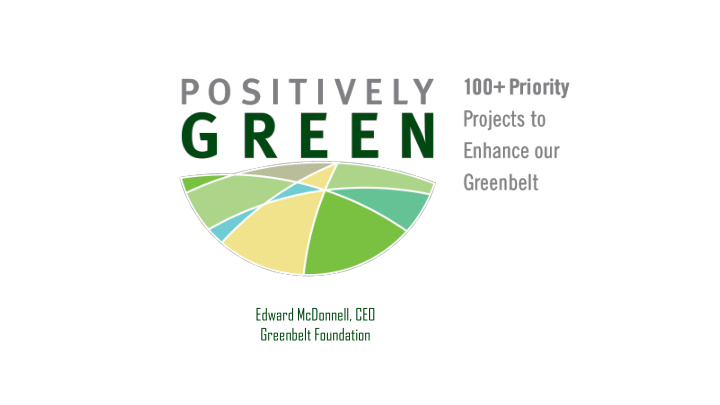



Edward McDonnell, CEO Greenbelt Foundation
Purpose 1. Introduce collaborative initiative developed by the Greenbelt Foundation and 13 conservation authorities including LSRCA 2. Secure endorsement and support for moving forward with outreach and fund proposals 2
Positively Green • Collaborative Greenbelt-wide initiative – Greenbelt Foundation and 13 CAs – In development since 2016 • 100+ priority projects – Directly benefits the public, municipalities, businesses and agriculture • Focuses on natural infrastructure: – nature’s role in climate adaptation and mitigation – the Greenbelt’s unparalleled environmental services 3
Measurable Outcomes Watershed Health – report card indicators/ project indicators. Ecosystem Services: valuations will define economic and public benefits of restoration projects. Climate Resiliency: flooding, pollution, species loss. Biodiversity: healthy, protected cores, connectivity, species recovery. Carbon Sequestration: substantial contribution to climate mitigation. Municipalities and investors are looking for regional impacts on larger systems 4
Natural Infrastructure Green Infrastructure Natural Assets Enhanced Assets Engineered Assets Rain Gardens Wetlands Permeable pavement Forests Bioswales Green Roofs Parks Urban Trees Rain Barrels Lakes/Rivers/Creeks Urban Parks Green Walls Fields Biomimicry Cisterns Stormwater pond Soil Credit MNAI “Green infrastructure” is a broad category that includes natural assets and designed and engineered elements that have been created to mimic natural functions and processes in the service of human interests 5
Natural Infrastructure • Natural Infrastructure – Improves water quality – Reduces the risk of floods – Ensures watersheds and communities are more resilient to District of West Vancouver, B.C. climate change – Supplements and works with traditional green/grey City of Nanaimo, B.C. infrastructure – Reducing costs and improves efficiency Region of Peel, Ontario 6
The Greenbelt The world’s largest greenbelt of its kind • – Over 2 million acres of protected land – Intact natural heritage system Protects environmentally sensitive areas and productive • farmlands – Almost 40% farmland Heart of the Greater Golden Horseshoe region – home to • 1 in 4 Canadians A unique Ontario solution for fresh air, clean water, local • food, thriving economies, and climate resilience 7
LSRCA Positively Green Projects 9 LSRCA projects include the following activities :\ Installing low impact development (LID) techniques to • infiltrate and/or harvest precipitation runoff and manage Greenbelt stormwater LSRCA Addressing perched culverts and removing online ponds • Installing vegetative buffer • Removing gabion baskets • Greenbelt Adding significant wetland • Establishing forest corridors along river valleys and • ecopassages for small wildlife 8
LSRCA Positively Green Projects Currently, 9 LSRCA projects identify municipal funds for the following outcomes : Improve water quality • Improve aquatic habitat • Increase community participation in stormwater • LSRCA management/stewardship projects LSRCA Repair streambank and restore stream health • Conserve provincially significant wetland • Reduce stormwater runoff • Greenbelt Greenbelt Increase public enjoyment and recreational use of the lake • Increase forest cover and connectivity • 9
LSRCA examples Implementing LID Approaches to Stormwater Addressing Brook Trout Habitat Fragmentation Management • Will reduce fragmentation of Brook Trout habitat in Focused on implementing LID approaches to stormwater • management, through voluntary stewardship projects Uxbridge Brook by addressing perched culverts and and opportunities through re-development removing online ponds Western Creek is one of the most heavily urbanized • subwatersheds in the Lake Simcoe basin, yet the older parts of the catchment lack stormwater controls Western Creek catchment is estimated to be one of the • major sources of phosphorus loading to the East Holland, and ultimately, to Lake Simcoe 10
Current landscape and recent challenges • Ontario conservation authorities are adjusting to recent and anticipated changes to their legislation, regulations, and funding • Nonetheless a compelling opportunity exists to pursue Greenbelt restoration and climate resiliency initiatives • Government investment, while significant, has funded relatively little natural infrastructure across the region • Positively Green is intended to bring additional funding and partners to natural infrastructure projects 11
Benefits of collaboration Stronger together • “Bundling” of projects creates the opportunity to meet thresholds for federal and provincial programs Shared outreach • Outreach to government officials and political representatives to raise awareness and advance engagement around our shared funding proposal. New fundraising capacity and opportunities • Shared approach to accessing private and public funds not otherwise available to individual CAs and projects. • While local fundraising and municipal investment will still be important, we can communicate a bigger regional resiliency and restoration opportunity that will appeal to major funding organizations while pooling fundraising resources now and through the lifespan of the initiative. Technical support and knowledge transfer • Targeted investment in individual project needs (e.g., business case development) and ensuring that we transfer knowledge and practical approaches throughout the CA collaborative to facilitate work on individual projects. 12
Branding Positively Green brand strikes the right tone for all audiences, and communicates the importance of the Greenbelt as natural Infrastructure. 13
Branding 14
Status • The Greenbelt Foundation has: – Conducted outreach to potential partners/funders • Budget submissions to the federal government • Provincial government outreach • Philanthropic and other major funders – Invested in collaborative program development, identity and branding, etc. • What/who is the funding for? – Project costs for proponents (municipalities, CAs, etc.), land securement, program administration – Conservation authority contributions will be in-kind and project-specific 15
Next steps • Endorsement of Positively Green from Conservation Authority Boards • The Greenbelt Foundation will continue outreach and relationship development – Federal, provincial, private and philanthropic – Next federal government • Continued work with Conservation Authority staff on project development 16
THANK YOU emcdonnell@greenbelt.ca
Recommend
More recommend